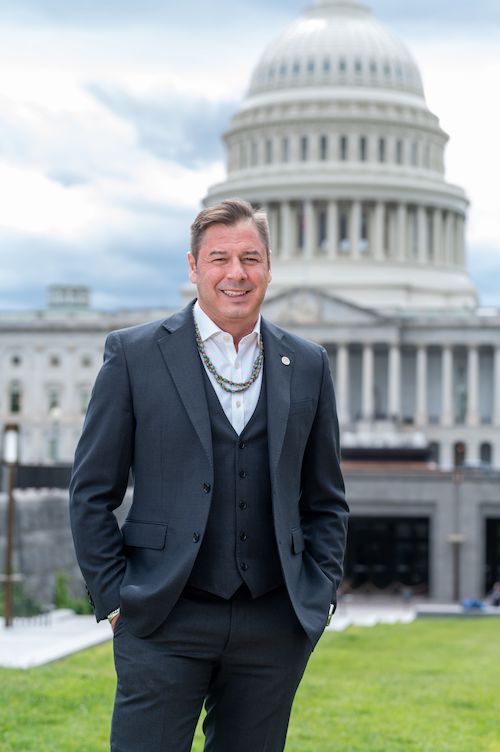Chris James, president and CEO of the National Center for American Indian Enterprise Development, has spent the last few days in Washington, D.C., meeting with policymakers to discuss his organization’s new assessment on how Trump administration policies are affecting Native communities.

Based on input from more than 100 tribal leaders and Native-serving organizations, the report outlines a range of concerns—from staffing reductions in federal agencies to canceled funding agreements and procurement changes that threaten decades of economic progress.
In a conversation Thursday with Tribal Business News, James discussed the report’s key findings and the mounting uncertainty across Indian Country.
This interview has been edited for clarity and brevity.
The report highlights the broad and deep impacts of Trump Administration policies. Which issues are creating the most immediate challenges in Indian Country?
There were quite a few, but three stood out. One is staffing shortages at the federal level. When agencies are understaffed, it affects tribes’ ability to get contracts, assistance, or follow through with anything. Another is the consolidation of federal contracting through GSA. That’s a big concern, especially for tribally owned and Native businesses that rely on the Buy Indian Act. And finally, there’s a lot of anxiety around cuts to Native CDFIs. The CDFI Fund is on the chopping block, and that’s something many people in Indian Country depend on.
Let’s talk more about those staffing reductions. Why are they hitting Native communities particularly hard?
A lot of our Native communities are in rural areas. They rely on either tribal or federal government programs for a wide range of assistance—health, education, workforce, infrastructure. When those programs get cut or delayed, it’s not just a minor inconvenience. It’s a major disruption. Some rural health departments, for example, get 100% of their funding from HHS. If that gets cut, those services just won’t exist. That trickles down across the community in ways that are hard to reverse.
You mentioned concerns about federal procurement. How might the president's order to consolidate federal purchasing under the General Services Administration (GSA) affect tribal businesses?
We’ve always supported the “Rule of Two”—if two small businesses can do the work, they should get the opportunity. But with everything moving to GSA, that platform just doesn’t work for a lot of our tribally owned businesses or smaller Native enterprises. Getting on a GSA schedule isn’t easy, and the concern is that this consolidation will benefit large companies at the expense of small ones, including those owned by tribes or Alaska Native corporations.
What about workforce capacity inside the federal government? Are we seeing a knowledge gap growing?
Absolutely. Over the years, there’s been a steady reduction in the federal workforce. I was at SBA during the Obama Administration, and we had a big reduction back in 2011–2012. Now, with even more people exiting—some of them the keepers of institutional knowledge—it’s becoming a real issue. And unfortunately, the newer hires who had just started to learn the ropes were among the first to be cut. That’s created a kind of perfect storm. The people with the knowledge are leaving, and the people gaining it are gone too.
Federal contracting and grantmaking rely on relationships and familiarity to make sure there’s continuity. How does federal turnover affect that dynamic?
Contracting in Indian Country is very relationship-based. It’s not transactional. You have to understand the uniqueness of Native communities. A lot of people still assume a Native-owned business is something small or handmade, like basket making. But some Native businesses are doing $400 million in federal contracts. When the people in government who understand that leave, we have to start over. We’re always ready to educate—but it slows everything down.
How is the uncertainty affecting long-term planning for tribal economic developers?
It’s making it really hard to plan—short-term, mid-term, or long-term. Contractors don’t know what’s coming down the pipeline. Federal agencies used to put out projections for the year; we’re seeing less of that now. On the grants side, people don’t know if funding will be renewed. One organization told us they had a staff of 30 and were 80% reliant on a HUD grant. If they can’t plan for that funding, how do they plan for anything? And with tariffs, supply chains, and rising costs, some small businesses can’t afford to operate more than two weeks out if something goes wrong.
The report also noted that some respondents see opportunities with the Trump Administration. What are those?
With every administration, there are opportunities. This one is very focused on supply chains and domestic manufacturing, and that could benefit Native manufacturers. There’s also the push to eliminate harmful food additives—that may seem small, but it matters to our kids. And on energy, the potential for tribes to do more self-determined development on their own lands is a positive. I’ve had good conversations with the White House and USTR. They’ve been willing to listen.
What are some of the immediate consequences you’ve seen at the National Center itself?
We’ve historically received two grants from the Minority Business Development Agency. Both were cut. That’s about $1.2 million in funding gone. We’re not laying anyone off, but we’ve had to retool our export program and scale back. Last year we supported over $100 million in contracts for Native businesses. I don’t know how much we’ll be able to support this year, but it will be different.
What are the next steps for your organization in light of this report?
We’re using it as an advocacy tool. I’ve been on the Hill meeting with members of Congress and administration officials to show them that these aren’t just stats—these are real people being affected. We’ve packaged it all in a way that helps them understand: this isn’t about a 40% cut on paper. This is about services disappearing in real communities.
What’s the one thing you want federal policymakers to understand right now?
That these policy decisions aren’t abstract. They affect real lives, real businesses, real tribal governments. And while we understand the need for change, we need to be part of that conversation—before it causes harm that can’t be undone.
